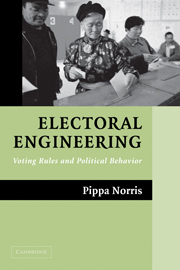Book contents
- Frontmatter
- Contents
- List of Tables and Figures
- Preface
- Electoral Engineering
- PART I INTRODUCTION
- 1 Do Rules Matter? Structure versus Culture
- 2 Classifying Electoral Systems
- 3 Evaluating Electoral Systems
- PART II THE CONSEQUENCES FOR VOTING BEHAVIOR
- PART III THE CONSEQUENCES FOR POLITICAL REPRESENTATION
- PART IV CONCLUSIONS
- Bibliography
- Notes
- Index
2 - Classifying Electoral Systems
Published online by Cambridge University Press: 05 September 2012
- Frontmatter
- Contents
- List of Tables and Figures
- Preface
- Electoral Engineering
- PART I INTRODUCTION
- 1 Do Rules Matter? Structure versus Culture
- 2 Classifying Electoral Systems
- 3 Evaluating Electoral Systems
- PART II THE CONSEQUENCES FOR VOTING BEHAVIOR
- PART III THE CONSEQUENCES FOR POLITICAL REPRESENTATION
- PART IV CONCLUSIONS
- Bibliography
- Notes
- Index
Summary
Before we can examine the impact of rules on voting behavior and political representation, I first need to outline a typology of the main families of electoral systems and classify their subtypes. The most important institutions influencing electoral rules can be divided into three nested components, ranging from the most diffuse to the most specific levels.
The constitutional structure represents the broadest institutional context, denoted, most importantly, by whether the executive is presidential or parliamentary, whether the national legislature is bicameral or unicameral, and whether power is centralized in unitary government or more widely dispersed through federal arrangements.
The electoral system concerns multiple aspects of electoral law, and the most basic features involve the ballot structure, determining how voters can express their choices, the electoral threshold, or the minimum votes needed by a party to secure representation, the electoral formula, determining how votes are counted to allocate seats, and the district magnitude, referring to the number of seats per district. Electoral systems are categorized in this study into three primary families: majoritarian, combined, and proportional, each with many subsidiary types.
Last, electoral procedures concern more detailed rules, codes of conduct, and official guidelines, including practical and technical issues that can also prove important to the outcome, such as the distribution of polling places, rules governing the nomination procedure for candidates, the qualifications for citizenship, facilities for voter registration and for casting a ballot, the design of the ballot paper, procedures for scrutiny of the election results, the use of compulsory voting, the process of boundary revisions, and regulations governing campaign finance and election broadcasting.
- Type
- Chapter
- Information
- Electoral EngineeringVoting Rules and Political Behavior, pp. 39 - 65Publisher: Cambridge University PressPrint publication year: 2004

